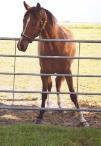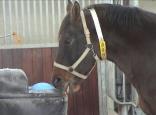Afwijkend gedrag
Afwijkend gedrag
Afwijkend gedrag wordt vaak getoond als reactie op de omgeving waarin het paard nu staat. Maar het gedrag ook kan zijn ontstaan in een omgeving waarin het paard vroeger stond. Deze omgeving heeft het paard overvraagd en het afwijkende gedrag is nu een gewoonte geworden, waardoor hij het in zijn nieuwe omgeving ook vertoond. Omdat het afwijkende gedrag niet helpt bij het aanpassen aan de omgeving, heeft het paard een risico op een welzijnsprobleem. Probeer daarom waar mogelijk de omgevingsfactoren (voeding, beweging, sociaal gedrag) optimaal aan te passen. Preventie van afwijkend gedrag zoals een nekband bij kribbebijten of luchtzuigen zorgt alleen voor symptoombestrijding, maar lost het onderliggende probleem niet op. Gebruik daarom alléén preventieve middelen wanneer de gezondheid van het paard direct in het geding komt (koliek, gewichtsverlies, schade aan gewrichten). Als het gedrag eenmaal is ontwikkeld zijn paarden zeer gemotiveerd om dit afwijkende gedrag te vertonen, bijna zo gemotiveerd als ze zijn voor voer. Het bestrijden van dit gedrag zal het welzijn dus kunnen verminderen, straffen helpt helemaal niet.
Vanuit welzijnsoogpunt moet er dan ook naar de onderliggende oorzaak worden gekeken. De oorzaak ligt vaak in het type huisvesting en voeding, bijvoorbeeld onvoldoende ruwvoer en het niet kunnen zien van andere paarden en de omgeving. Voorkom dat er afwijkend gedrag ontstaat door waar mogelijk de omgevingsfactoren optimaal aan te passen aan de hand van de resultaten van de Paardenwelzijnscheck.
Weven
Het paard staat afwisselend op het linker en het rechter voorbeen, waardoor het lichaam heen en weer beweegt. Het hoofd van het paard 'zwaait' vaak het meeste heen en weer. Weven zorgt voor overmatige slijtage van de hoeven en het bewegingsapparaat. Uit onderzoek blijkt dat weven verminderd kan worden wanneer een paard soortgenoten aan weerszijde van de stal heeft staan waarbij ze elkaar volledig kunnen zien en neuscontact aanwezig is.

Kribbebijten
Het paard plaatst zijn snijtanden op een stevig object zoals een hek of staldeur. Dan spant het paard zijn nekspieren en lijkt het lucht naar binnen te zuigen, dit veroorzaakt een burpend geluid. Omdat paarden op stal soms niet de hele dag door gras of ruwvoer krijgen, wat wel het geval is in een natuurlijke situatie, komt er minder speeksel vrij. Hierdoor ontstaat een zure maag en dat kan resulteren in maagzweren. Omdat de paarden niet constant op voer kunnen kauwen zoeken ze een andere substantie, ze gaan op hout knagen of gaan kribbebijten, waarbij speeksel vrijkomt wat de maag minder zuur maakt. Slechts een klein deel van de lucht die de bovenste slokdarm uitzet wordt getransporteerd naar de maag.
Kribbebijten wordt in verband gebracht met maagzweren en tanderosie. Om het afslijten van de tanden te voorkomen, kunnen de plaatsen waar het paard kribbebijt met rubber worden afgezet. Hoewel de tandslijtage eigenlijk niet voor pijn kan zorgen, omdat de zenuwen niet worden blootgesteld, kan een paard met tandslijtage moeite hebben met het kauwen en grijpen van zijn voer. Hierdoor kunnen ze gewicht verliezen.

Wetenschappelijke onderbouwing: Cooper & McGreevy, 2002; McBride & Long, 2001, McGreevy et al., 2001; Nicol, 1999a; Nicol, 1999b; Nicol et al., 2001; McGreevy & Nicol, 1998a; Hayes, 1968; Lane, 1998; Marr (2012); Hillyer et al., 2002; Archer et al., 2004; Malamed et al., 2010; Wickens & Heleski, 201; McBride and Long, 2001; Wickens, 2009; Baker and Kear-Colwell, 1974; Delacalle et al., 2002; McBride and Cuddeford, 2001; Nagy et al., 2009; McGreevy and Nicol, 1998c; Cooper & McGreevy, 2002; McGreevy & Nicol, 1998c; Boyd, 1986; Nicol (1999a, b; McBride & Cuddeford, 2001; Cooper & Albentosa, 2005; McGreevy and Nicol, 1998a; Cooper and McGreevy, 2002; McBride and Cuddeford, 2001; McGreevy and Nicol, 1998c; McBride and Cuddeford, 2001; Cooper and Nicol, 1993; Lebelt et al., 1998, McGreevy and Nicol, 1998b, McBride and Cuddeford, 2001; Nicol, 1999; McGreevy and Nicol, 1998b; Nicol, 1999a; Rowe et al., 1994; Murray and Eichorn, 1996; Willard et al., 1977; Willard et al., 1977; Waters et al., 2002; Johnson et al., 1998; Nicol, 1999a; Nicol et al., 2002; Nicol et al., 2002; Mills and Macleod, 2002; Henderson, 2007; Luescher et al., 1991; Mason, 1991; Mason & Latham, 2004; Cooper & Albentosa, 2005; Mason, 1991; McGreevy, 1997; Mason & Latham, 2004; Mason et al., 2006; Christie et al., 2006; Nicol, 1999b; McGreevy et al., 1995c:
Klik hier voor een totaaloverzicht van de wetenschappelijke onderbouwing bij afwijkend gedrag
References
1. Archer, D.C., Freeman, D.E., Doyle, A.J., Proudman, C.J. and Edwards, G.B. (2004) Association between cribbing and entrapment of the small intestine in the epiploic foramen in horses: 68 cases (1991–2002). J. Am. Vet. Med. Ass. 224, 562-230.
2. Baker, G.J., Kear-Colwell, J., (1974). Aerophagia (windsucking) and aversion therapy in the horse. Proc. Am. Assoc. Equine Pract. 20, 127–130.
3. Boyd, L. (1986). Behavior problems of equids in zoos. The Veterinary Clinics of North America. Equine Practice, 2(3):653-664.
4. Christie, J.L., Hewson, C.J., Riley, C.B., McNiven, M.A., Dohoo, I.R., & Bate, L.A. (2006). Management factors affecting stereotypies and body condition score in nonracing horses in Prince Edward Island. The Canadian Veterinary Journal, 47(2)136-143.
5. Cooper, J. and McGreevy, P. (2002) Stereotypical behaviour in the stabled horse: causes, effects and prevention without compromising welfare. In Waran, N. (ed.) The Welfare of Horses. Kluwer Academic Publishers, Dordrecht, The Netherlands, pp 99-124.
6. Cooper, J.J., Albentosa,M.J. (2005) Behavioural adaptation in the domestic horse: potential role of apparently abnormal responses including stereotypic behaviour. Livestock Production Science 92, 177–182.
7. Cooper, J.J., Nicol, C.J. (1993). The ‘coping’ hypothesis of stereotypies. Anim. Behav. 45, 616– 618.
8. Dantzer, R. (1986). Behavioral, physiological and functional aspects of stereotypy: A review and reinterpretation. Journal of Animal Science, 62, 1776-1786.
9. Delacalle, J., Burba, D.J., Tetens, J., Moore, R.M. (2002). Nd:YAGlaser-assisted modified Forssell’s procedure for treatment of cribbing (crib-biting) in horses. Vet. Surg. 31, 111–116.
10. Hayes, M.H. (1968) Veterinary Notes for Horse-owners, Sixteenth Edition. Stanley Paul, London.
11. Hillyer, M.H., Taylor, F.G., Proudman, C.J., Edwards, G.B., Smith, J.E. and French, N.P. (2002). Case control study to identify risk factors for simple colonic obstruction and distension colic in horses. Equine Vet. J. 34, 455-463.
12. Houpt, K.A., Crowley, L., Rousseliere, A. (2005). Operant learning as ameans of measuring equine motivation to crib: a vice or a need? Anthrozoös 18 (3), 320–321.
13. Johnson, K.G., Tyrrell, J., Rowe, J.B., Petherick, D.W. (1998). Behavioural changes in stabled horses given non-therapeutic levels of virginiamycin. Equine Vet. J. 30, 139– 142.
14. Lane, J.G. (1998) Recent studies on crib-biting horses. Equine Veterinary J. Suppl. 27, 59.
15. Lebelt, D., Zanella, A.J. and Unshelm, J. (1998) Physiological correlates associated with cribbing behaviour in horses; changes in thermal threshold, heart rate, plasma B-endorphin and serotonin. Equine Veterinary J. Suppl. 27, 21–27.
16. Luescher, U.A., McKeown, D.B., & Halip, J. (1991). Reviewing the causes of obsessive-compulsive disorders in horses. Veterinary Medicine, 86, 527-530.
17. Malamed, R., Berger, J., Bain, M.J., Kass, P. and Spier, S.J. (2010). Retrospective evaluation of crib-biting and windsucking behaviours and owner-perceived behavioural traits as risk factors for colic in horses. Equine Vet. J. 42, 686-692.
18. Marr, C.M. (2012). On the question of colic: Are answers beginning to emerge? Equine Veterinary Journal 44, 384–386
19. Mason, G.J. (1991). Stereotypies: A critical review. Animal Behavior, 41, 1015-1037.
20. Mason, G.J., & Latham, N.R. (2004). Can’t stop, won’t stop: Is stereotypy a reliable animal welfare indicator? Animal welfare, 13, 557-569.
21. Mason, G.J., Clubb, R., Latham, N., & Vickery, S. (2006). Why and how should we use environmental enrichment to tackle stereotypic behavior? Applied Animal Behavior Science, 102, 163-188.
22. McBride, S.D and Long, L. (2001) Management of horses showing stereotypic behaviour, owner perception and the implications for welfare. Veterinary Record 148, 799–802.
23. McBride, S.D. and Cuddeford, D. (2001) The putative welfare-reducing effects of preventing equine stereotypic behaviour. Animal Welfare 10, 173–189.
24. McGreevy, P.D. (1997). Do stabled horses cope? Journal of Biological Education, 31, 207-211.
25. McGreevy, P.D. and Nicol, C.J. (1998a). Prevention of crib-biting: a review. Equine Veterinary J. Suppl. 27, 35–38.
26. McGreevy, P.D. and Nicol, C.J. (1998b). Physiological and behavioural consequences associated with short-term prevention of crib-biting in horses. Physiology and Behaviour 65, 15–23.
27. McGreevy, P.D. and Nicol, C.J. (1998c). The effect of short term prevention on the subsequent rate of crib-biting in Thoroughbred horses. Equine Vet. J. Suppl. 27, 30–34.
28. McGreevy, P.D., French, N.P. and Nicol, C.J. (1995). The prevalence of abnormal behaviours in dressage, eventing and endurance horses in relation to stabling. Veterinary Record 137, 36–37.
29. McGreevy, P.D., Webster, A.J.F. and C.J. Nicol. (2001). Study of the digestive efficiency, behaviour and gut transit times of crib-biting horses. Veterinary Record 148, 592–596.
30. Mills, D.S., & Macleod, C.A., (2002). The response of crib-biting and windsucking in horses to dietary supplementation with an antacid mixture. Ippologia 13, 33– 41.
31. Murray, M.J., & Eichorn, E.S., (1996). Effects of intermittent feed deprivation, intermittent feed deprivation with ranitidine administration, and stall confinement with ad libitum access to hay on gastric ulceration in horses. Am. J. Vet. Res. 11, 1599– 1603.
32. Nagy, K., Bodó, G., Bárdos, G., Harnos, A., Kabai, P. (2009). The effect of a feeding stress-test on the behavior and heart rate variability of control and crib-biting horses (with or without inhibition). Appl. Anim. Behav. Sci. 121, 140–147.
33. Nicol, C.J. (1999a). Understanding equine stereotypies. Equine Veterinary J. Suppl. 28, 20–25.
34. Nicol, C.J. (1999b). Stereotypies and their relation to management. In Harris PA, Gomarsall GM, Davidson HPB, Green RE (Eds), Proceedings BEVA Specialist Days on Behaviour and Nutrition, pp 11-14.
35. Nicol, C.J., Davidson, H.P.B., Harris, P.A., Waters, A.J., Wilson, A.D., (2002). Study of crib-biting and gastric inflammation and ulceration in young horses. Vet. Rec. 151, 658–661.
36. Nicol, C.J., Wilson, A.D., Waters, A.J., Harris, P.A. and Davidson, H.P.B. (2001) Crib-biting on foals is associated with gastric ulceration and mucosal inflammation. In Garner, J.P., Mench, J.A. and Heekin, S.P. (eds.), Proceedings 35th International Society for Applied Ethology Congress. Centre for Animal Welfare; California, USA.
37. Redbo, I., Redbo-Torstensson, P., Odberg, F.O., Henderdahl, A., Holm, J. (1998). Factors affecting behavioural disturbances in racehorses. Anim. Sci. 66, 475–481.
38. Ritzberger-Matter, G. and Kaegi, B. (1998). Retrospective analysis of the success rate of surgical treatment of aerophagia in horse at the Veterinary Surgical Clinic, University of Zurich. Equine Veterinary J. Suppl. 27, 62.
39. Rowe, J.B., Lees, M.J., Pethick, D.W. (1994). Prevention of acidosis and laminitis associated with grain feeding in horses. J. Nutr. 124, 2742–2744.
40. Sambraus, H.H. and Rappold, D. (1991). Crib-biting and wind-sucking in horses. Pferdeheilkunde 7, 211–216.
41. Waters, A.J., Nicol, C.J., French, N.P., (2002). The development of stereotypic and redirected behaviours in young horses: the findings of a four-year prospective epidemiological study. Equine Vet. J. 34, 572– 579.
42. Wickens CL., Heleski CR. (2010). Crib-biting behavior in horses: A review. Applied Animal Behaviour Science, Volume 128, Issues 1–4, Pages 1–9
43. Wickens, C.L. (2009). Investigating specific stereotypic behaviors in horses. Ph.D. dissertation, Michigan State University, East Lansing
44. Willard, J.G., Willard, J.C., Wolfram, S.A., Baker, J.P., (1977). Effect of diet on cecal pH and feeding behaviour of horses. J. Anim. Sci. 45, 87–93.